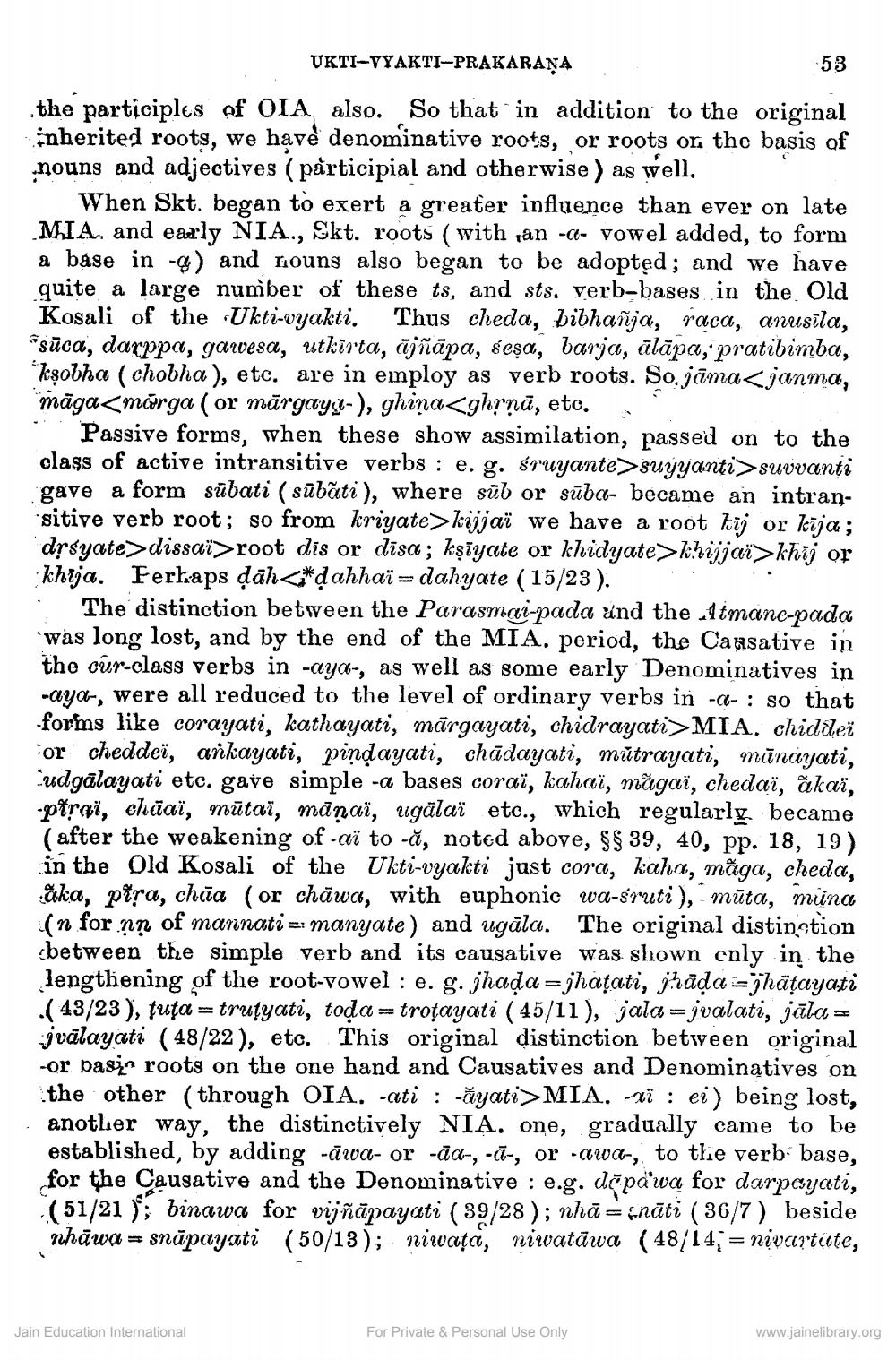________________
UKTI-VYAKTI-PRAKARAŅA
53
the participles of OIA, also. So that in addition to the original inherited roots, we have denominative roots, or roots on the basis of .nouns and adjectives (participial and otherwise) as well.
When Skt. began to exert a greater influence than ever on late MIA. and eaxly NIA., Skt. roots (with an -a- vowel added, to form a base in ) and nouns also began to be adopted; and we have quite a large number of these ts, and sts. verb-bases in the Old Kosali of the Ukti-vyakti. Thus cheda, bibhanja, raca, anusila, *sūca, darppa, gawesa, utkirta, ājñāpa, écşa, barja, ālūpa, pratibimba, kṣobha (chobha), etc. are in employ as verb roots. So. jāma<janma, Māga<märga (or mārgay-), ghiņa<ghrņā, etc.
Passive forms, when these show assimilation, passed on to the class of active intransitive verbs : e. g. sruyante>suyyanti>suvvanti gave a form sūbati ( sūbāti), where süb or sūbce- became an intran. sitive verb root; so from kriyate> kijjaï we have a root hij or kīja; drsyate>dissaï>root dis or disa; kşīyate or khidyate>khijjaï>khīj or khīja. Ferhaps ņāh<tdahhaï = dahyate (15/23). . • The distinction between the Parasmai-pada and the Atmane-pada 'was long lost, and by the end of the MIA. period, the Causative in the cur-class verbs in -aya-, as well as some early Denominatives in -aya-, were all reduced to the level of ordinary verbs in -a- : so that .forms like corayati, kathayati, mārgayati, chidrayati>MIA. chiddeï or cheddeë, ankayati, pindayati, chūdayati, mutrayati, mānayati, udgālayati etc. gave simple -a bases corai, kahaï, măgaï, chedaż, akaï, -ptræï, chāaï, mūtas, māņaï, ugālaï etc., which regularly became (after the weakening of -aï to -ă, noted above, $$ 39, 40, pp. 18, 19) in the Old Kosali of the Ukti-vyakti just cora, kaha, măga, cheda, õka, pira, chữa (or chāwc, with euphonic wa-śruti), mūta, muna (n for ņņ of mannati =: manyate) and ugāla. The original distinction between the simple verb and its causative was shown only in the lengthening of the root-vowel : e. g. jhada=jhatati, jhāda =jhāțayati .( 43/23 ), tuta=trutyati, toda = troțayati ( 45/11), jala=jvalati, jāla = gvālayati (48/22), etc. This original distinction between original -or pasir roots on the one hand and Causatives and Denominatives on the other (through OIA. -ati : -yati>MIA. -17 : ei) being lost, another way. the distinctively NIA. one, gradually came to be established, by adding -awa- or -āc-, --, or -awa-, to the verb base, for the Causative and the Denominative : e.g. döpawa for darpcyati, (51/21 ) binawa for vijñāpayati ( 39/28 ); nhā=ināti ( 36/7) beside nhāwa = snāpayati (50/13); niwatai, niwatāwa (48/14; = nivartate,
Jain Education International
For Private & Personal Use Only
www.jainelibrary.org




